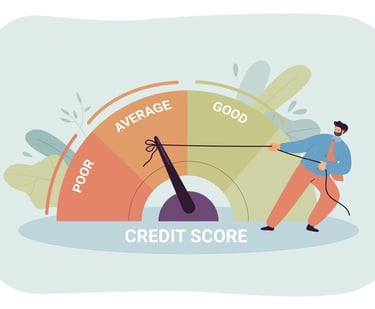Understanding the Benefits of a Loan Modification
10 min read


What is a Loan Modification?
A loan modification is a permanent change to an existing loan to make it more manageable.
It is a change made to the terms of your existing mortgage by your lender.
A loan modification is designed to help borrowers experiencing long-term financial hardship. There are various loan modification options available to help borrowers, including programs like the FHA loan modification and the Flex Modification program from Fannie Mae and Freddie Mac
Benefits of a Loan Modification
A loan modification can help homeowners who are struggling to make their mortgage payments or who have fallen behind on their loans.
It can lower the monthly payment to make it more manageable.
A loan modification can help avoid foreclosure and keep your home.
It can provide long-term financial relief for homeowners struggling to make mortgage payments.
Who Can Qualify for a Loan Modification?
Homeowners who have missed mortgage payments or are in a financial situation where there's a high likelihood of missing a payment should address any missed payment promptly to qualify for a loan modification. They may qualify if they can demonstrate significant financial hardship.
Homeowners who are coming out of forbearance but unable to resume regular mortgage payments are also often eligible for loan modifications.
Financial situations that could qualify include the loss of a job, loss of a spouse, or a disability or illness that has affected your ability to repay your mortgage.
Types of Loan Modifications
The loan modification you're offered will likely depend on the type of home loan you have.
Conventional loans, which are held by Freddie Mac and Fannie Mae, have different modification programs from government-backed loans like FHA loans and VA loans.
FHA loan modification programs, offered by the Federal Housing Administration, can help struggling homeowners by reducing the interest rate, extending the loan term, or reducing the principal balance.
VA loan modification programs can help veterans and their families by reducing the interest rate, extending the loan term, or reducing the principal balance
The Loan Modification Process
The loan modification process is a series of steps that homeowners can take to modify their existing mortgage loan and make their monthly payments more manageable. This process typically involves contacting the mortgage lender, providing financial documentation, and receiving a loan modification offer. Understanding each step can help homeowners navigate the process more effectively and increase their chances of securing a favorable modification
Contacting Your Mortgage Lender
The first step in the loan modification process is to contact your mortgage lender. Homeowners should reach out to their lender as soon as they realize they are having trouble making their monthly mortgage payments. It's essential to be proactive and communicate with the lender to avoid falling behind on payments.
When contacting the lender, homeowners should be prepared to explain their financial situation and provide information about their income, expenses, and assets. The lender will use this information to determine whether the homeowner is eligible for a loan modification. Being transparent and forthcoming with your lender can help expedite the process and improve your chances of receiving assistance.
Complete Loss Mitigation Application
Once you've spoken with your lender and determined that a loan modification is the best course of action, you'll need to complete a loss mitigation application. This application is a formal request for assistance and will require you to provide detailed information about your financial situation.
To complete the application, you'll typically need to provide the following documentation:
Proof of income: This may include pay stubs, W-2 forms, and tax returns.
Proof of expenses: This may include bank statements, credit card statements, and utility bills.
Proof of financial hardship: This may include a letter from your employer, a doctor's note, or other documentation that explains your financial situation.
Information about your mortgage: This may include your loan account number, the current balance, and the interest rate.
You may be able to submit your application electronically or by mail. Be sure to keep a copy of your application and supporting documentation for your records. This will help you track your progress and provide any additional information your lender may request.
Providing Financial Documentation
Once the lender has determined that the homeowner is eligible for a loan modification, the next step is to provide financial documentation. This documentation may include:
Proof of income, such as pay stubs and W-2 forms
Bank statements and credit card statements
Tax returns and other financial records
A letter explaining the financial hardship and how it has affected the ability to make mortgage payments
The lender will review this documentation to determine the best course of action for the loan modification. Homeowners should be prepared to provide additional documentation as needed. Ensuring that all documents are accurate and up-to-date can help streamline the process and lead to a more favorable outcome.
By understanding and following these steps, homeowners can take proactive measures to secure a loan modification, making their monthly mortgage payments more manageable and avoiding the risk of foreclosure.
Review and Approval Process
Once you've submitted your loss mitigation application, your lender will review it to determine whether you qualify for a loan modification. This process may take several weeks or even months, so be patient and don't hesitate to follow up with your lender if you have any questions or concerns.
If your application is approved, your lender will send you a loan modification agreement that outlines the terms of the modification. This agreement may include changes to your interest rate, loan term, or monthly payment amount.
Before signing the agreement, be sure to carefully review the terms and ask any questions you may have. It's also a good idea to have a financial advisor or attorney review the agreement to ensure that it's in your best interests.
Once you've signed the agreement, your lender will update your loan records and you'll begin making payments under the new terms. This new arrangement can help make your monthly mortgage payments more manageable and provide the financial relief you need
Common Challenges in Loan Modification
Loan modification can be a complex and challenging process for homeowners. Some common challenges that borrowers may face during the loan modification process include:
Lack of clear communication: Effective communication with your mortgage lender is crucial. However, borrowers often experience difficulty in reaching their lender or servicer, leading to misunderstandings and delays. It's important to keep detailed records of all communications and follow up regularly.
Insufficient documentation: Gathering the required documentation, such as income records and financial statements, can be overwhelming. Missing or incomplete documents can slow down the loan modification process. Ensure you have all necessary paperwork ready and organized to avoid delays.
Inadequate income: To qualify for a loan modification, borrowers must demonstrate sufficient income to meet the modified loan terms. If your income is too low, it may be challenging to obtain approval. Consider all sources of income and be prepared to provide detailed proof.
High debt-to-income ratio: Lenders assess your debt-to-income ratio to determine your ability to repay the loan. A high ratio may classify you as high-risk, making it difficult to secure a loan modification. Work on reducing your debt where possible to improve your chances.
Lack of flexibility: Some lenders may not offer flexible terms, such as reduced interest rates or extended loan terms, which can make it difficult for borrowers to qualify for a loan modification. It's important to understand your lender's policies and explore all available options.
By being aware of these challenges and proactively addressing them, you can navigate the loan modification process more effectively and increase your chances of success.
Legal Considerations in Loan Modification
Loan modification involves a range of legal considerations that borrowers should be aware of. Understanding these legal aspects can help you navigate the process more confidently and avoid potential pitfalls.
Contractual obligations: Your original loan agreement is a binding contract, and any modifications must comply with its terms. This may limit your ability to negotiate certain changes. It's essential to review your original loan documents and understand your contractual obligations.
State and federal laws: Borrowers are protected by various state and federal laws, such as the Truth in Lending Act (TILA) and the Real Estate Settlement Procedures Act (RESPA). These laws regulate the loan modification process and ensure that lenders provide clear and accurate information.
Disclosure requirements: Lenders are required to disclose specific information during the loan modification process, including the terms of the modification and any associated fees. Make sure you receive and understand all disclosures before agreeing to any changes.
Tax implications: A loan modification may have tax consequences, such as the forgiveness of debt income, which could be considered taxable. Consult with a tax professional to understand how a loan modification might impact your tax situation.
Credit reporting: A loan modification can affect your credit report and credit score. While the impact is typically less severe than foreclosure, it's important to monitor your credit and understand how the modification will be reported.
By being aware of these legal considerations, you can better protect your interests and make informed decisions throughout the loan modification process
How to Get a Mortgage Loan Modification
If you're struggling to make your mortgage payments, contact your lender or servicer as soon as possible to ask about your options.
Your application for a mortgage modification must be submitted at least 90 days before a scheduled foreclosure sale.
The loan modification process typically involves gathering information about your financial situation, reaching out to your lender, checking qualifications, and completing an application. It is crucial to address any missed payments promptly to explore loan modification options, as each additional missed mortgage payment can limit your available options. Addressing any missed payment promptly is crucial, as each additional missed payment can limit your available loan modification options
The Role of a Mortgage Lender
Mortgage lenders consider your credit history, income, debt, and financial resources to determine eligibility for a loan modification.
They may implement one or more mortgage modifications to make a mortgage more affordable.
Options can differ based on the type of loan and may include changes to interest rates, loan structures, or both.
Impact on Long-term Financial Planning
A loan modification can have a significant impact on a borrower's long-term financial planning. It's important to consider how the changes to your mortgage will affect your overall financial strategy.
Increased borrowing costs: While a loan modification can lower your monthly payments, it may also result in increased borrowing costs over the life of the loan. This can impact your long-term financial goals, such as saving for retirement or other major expenses.
Credit score impact: A loan modification may affect your credit score, which can influence your ability to obtain credit in the future. It's important to monitor your credit report and take steps to rebuild your credit if necessary.
Retirement planning: Adjusting your mortgage payments can affect your retirement planning. You may need to increase your retirement contributions or adjust your investment portfolio to ensure you stay on track with your retirement goals.
Estate planning: Changes to your mortgage terms may require updates to your estate planning documents, such as your will and trusts. Ensure that your estate plan reflects your current financial situation and goals.
Long-term financial goals: Consider how a loan modification may impact your long-term financial goals, such as saving for a down payment on a new home or funding your children's education. Adjust your financial plans accordingly to stay on track.
By carefully considering these factors, you can make informed decisions about your loan modification and its impact on your long-term financial planning
Alternatives to a Loan Modification
If a loan modification isn't right for you, consider alternatives such as refinancing, forbearance, or recasting.
Explore options for navigating your mortgage during financial hardship. It's crucial to address loan payments during these times to explore all available alternatives.
A refinance makes sense when you're experiencing a temporary financial hardship and need a short-term solution to your mortgage payments.
If none of these are good options, consider selling to a cash buyer like Grace Hill Solutions. We'll make the process smooth and help you every step of the way
How Does a Loan Modification Affect Your Credit?
A loan modification can temporarily affect your credit scores.
The impact is typically less severe than foreclosure.
Monitor your credit reports and scores to track your recovery.
Working with a Mortgage Lender
Working with a mortgage lender can be a challenging and intimidating experience, especially if you're facing financial hardship. However, it's essential to remember that your lender is there to help you. Here are some tips for working with a mortgage lender:
Be honest and transparent: Be upfront about your financial situation and provide accurate information about your income, expenses, and financial hardship.
Communicate regularly: Keep in touch with your lender throughout the loan modification process and ask questions if you have any concerns.
Seek professional advice: Consider working with a financial advisor or attorney who can help you navigate the loan modification process and ensure that you're getting the best possible deal.
Don't be afraid to negotiate: If you're not happy with the terms of the loan modification agreement, don't be afraid to negotiate with your lender.
By following these tips and working closely with your lender, you can increase your chances of getting approved for a loan modification and avoiding foreclosure.
Some popular mortgage lenders that offer loan modification programs include:
Fannie Mae
Freddie Mac
Federal Housing Administration (FHA)
Department of Veterans Affairs (VA)
These lenders offer a range of loan modification options, including interest rate reductions, loan term extensions, and principal reductions. They also offer resources and support to help you navigate the loan modification process and avoid foreclosure.
Remember, a loan modification is a serious commitment that can have long-term consequences for your financial situation. Be sure to carefully consider your options and seek professional advice before making a decision
The Bottom Line
A loan modification can be a great tool to avoid a mortgage default if you're currently facing financial hardship.
Depending on the terms and the type of loan you have, there are multiple ways you can work with your lender to reduce your payments and/or add past due payments to your principle.
A loan modification can help you keep your home by lowering monthly payments, but it may increase long-term borrowing costs and temporarily affect credit scores. If you find yourself behind on your mortgage, it is crucial to act quickly to explore loan modification options and prevent further financial issues such as foreclosure.
Ultimately, if you find these options to be too overwhelming and would like to sell, please contact Grace Hill Solutions and we'll walk you through the process of selling your house easily.








